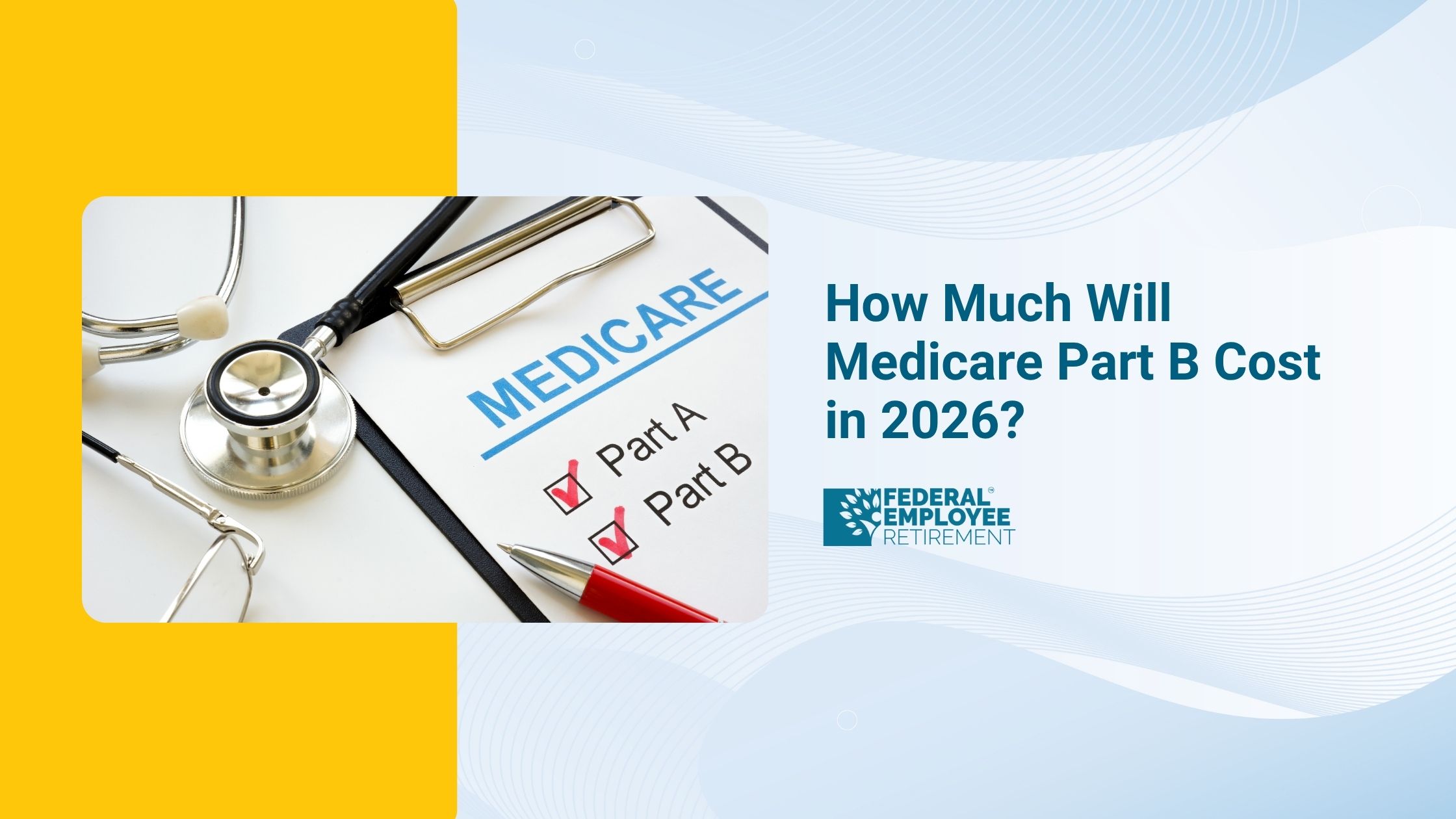You’re not alone; 4,359 federal employees booked their free review.

How Much Will Medicare Part B Cost in 2026?
If you’re a federal employee planning for retirement or already receiving your annuity one of the biggest questions on your mind this year is:
“How much will Medicare Part B cost in 2026?”
The answer: about $206.50 per month, up from $185 in 2025. That’s a 12% increase, making 2026 one of the steeper jumps in recent years. The annual deductible is also projected to rise to $288.
For retirees living on a fixed income, those figures matter. In our experience advising federal employees, even small Medicare changes can have a real impact on take-home pay and benefit coordination. But there’s more to this story than just one premium number.
This year’s Medicare cost changes come at a time of shifting policies telehealth coverage, prescription drug reforms, and even government funding uncertainties all of which can affect retirees’ budgets and access to care
Let’s unpack what’s changing, why it’s happening, and how you can protect your benefits heading into 2026.
The Cost of Medicare Part B in 2026 Key Facts and Trends
To start, here are the latest projections from the Centers for Medicare & Medicaid Services (CMS) and leading policy analysts:
Sources: CMS, Kiplinger, Medical News Today, MedicareResources.org (2025–2026 projections)
So, to directly answer the top search question:
How much will Medicare Part B cost in 2026?
The standard premium will be approximately $206.50/month, and the annual deductible about $288.
Why Medicare Costs Are Rising
The increase in the cost of Medicare Part B in 2026 reflects deeper trends, not a one-year anomaly. Here’s what’s driving it:
- Higher utilization: Americans are using more outpatient services after years of deferred care.
- Medical inflation: Costs for hospital and physician services are climbing faster than general inflation.
- New treatment costs: Expensive new therapies, such as injectable drugs and weight-loss medications, are adding strain to Medicare’s budget.
- Trust-fund adjustments: Premiums are partly raised to ensure long-term solvency of the Part B trust fund.
- Administrative pressure: Broader government fiscal constraints, including potential shutdowns, could affect program operations and payment timelines.
In short, the system is trying to keep pace with both demand and sustainability but retirees bear much of that adjustment through premium increases.
Other Medicare Changes Affecting 2026 Costs
Beyond premiums, retirees should be aware of a few key shifts that may influence overall Medicare expenses and coverage options:
1. Telehealth Restrictions
Temporary telehealth flexibilities expired in late 2025. Unless Congress renews them, retirees especially in rural areas may lose access to virtual visits or face higher travel costs.
As Dr. Kanwar Kelley (Side Health) told Medical News Today, reduced telehealth could “increase downstream costs and worse outcomes” for those with mobility challenges.
Advisor Insight: We’ve seen many federal retirees rely on telehealth to manage chronic conditions efficiently. If these changes hold, plan accordingly for more in-person visits or seek FEHB plans that emphasize coordinated care.
2. Medicare Advantage and Part D Shifts
- The number of Medicare Advantage plans will stay near 5,600, but some insurers like United Healthcare are scaling back service areas.
- The average monthly premium for these plans will drop from $16 to $14, but that doesn’t always mean savings; coverage networks may narrow.
- Part D drug plan premiums are expected to decrease to $34, but the annual deductible limit will rise to $615.
- CMS will continue negotiating drug prices for 10 popular medications (like Eliquis, Xarelto, Januvia, Jardiance). Savings could reach 38–79%, but fewer plan choices mean retirees should review drug lists carefully.
3. Out-of-Pocket Cost Caps
- Medicare Advantage out-of-pocket limits will fall slightly to $9,250.
- The annual Part D drug spending cap increases to $2,100, offering more predictable cost protection over time.
- Insulin costs remain capped at $35 per month, and most vaccines will still be covered under Part D.
How Rising Medicare Costs Affect Federal Retirees
This is where the federal perspective matters most. While many media outlets cover Medicare broadly, few address how these changes intersect with FEHB (Federal Employees Health Benefits) and FERS/CSRS annuities.
Here’s what we’re seeing:
1. Smaller Net Annuity Payments
For retirees whose Part B premiums are deducted from Social Security, a 12% increase could offset much of the 2.8% projected COLA.
Example:
If your monthly Social Security payment rises by $60, but your Part B premium increases by $21, your actual monthly net gain is just $39 before any FEHB premium changes.
2. FEHB + Medicare Coordination
Many federal retirees keep FEHB alongside Medicare Part B. The right pairing can reduce out-of-pocket costs dramatically but the wrong combination can be expensive.
For instance:
- Some FEHB plans, such as BCBS Basic and GEHA High, offer Part B premium reimbursements of up to $800–$900 per person per year.
- Others may reduce copayments or waive deductibles if you enroll in Part B.
Advisor Insight: In our reviews, we often find retirees unaware of these reimbursement benefits even though they can offset half of next year’s premium increase.
3. IRMAA Implications
Higher-income retirees (typically $103,000+ single / $206,000+ joint in 2026, projected) will pay additional Income-Related Monthly Adjustment Amounts (IRMAA).
Managing taxable income such as the timing of TSP withdrawals or Roth conversions can help avoid these surcharges.
4. Rural and Access Concerns
If you live outside a metro area, reduced telehealth coverage and fewer Medicare Advantage options could limit provider access. In such cases, keeping a robust FEHB plan may be worth the extra cost for flexibility.
Action Plan: How Federal Retirees Can Prepare Now
With premiums rising, Open Season (Oct 15 – Dec 7) is your opportunity to act strategically not reactively. Here’s how:
1. Compare FEHB Plans Now
Review whether your current FEHB plan offers a Medicare Part B reimbursement or extra value for Medicare enrollees.
Plans like Blue Cross Basic, NALC High, and GEHA High Option often provide these incentives.
2. Review Prescription Coverage
If you’re enrolled in a standalone Part D plan, confirm that your medications remain covered affordably. Formularies often change year to year.
3. Manage Taxable Income
Use Roth conversions or controlled TSP withdrawals to stay below IRMAA thresholds. This step can save hundreds annually in Medicare surcharges.
4. Build Health-Care Inflation into Your Budget
The difference between $185 and $206.50 may not seem large month to month, but it’s $258 more per year per person or $516 for a retired couple.
Schedule a Benefits Review
A personalized federal retirement benefits consultation can identify savings opportunities that online plan comparisons miss especially for those coordinating FEHB an
Key Takeaways
- How much will Medicare Part B cost in 2026? → About $206.50 per month, with a $288 deductible.
- Why it matters: It’s a 12% increase the largest in several years.
- Federal impact: COLA gains may be reduced, and FEHB coordination becomes more important than ever.
- Action: Review your FEHB plan, income levels, and drug coverage before Open Season ends.
In Our Experience…
We’ve worked with thousands of federal employees and retirees through transitions like this. The ones who fare best are those who don’t wait until January to react to changes.
They use the Open Season window to:
- Compare plans side by side,
- Review income projections, and
- Plan Medicare enrollment timing carefully.
A few hours of proactive review often prevent costly oversights like paying for overlapping coverage or missing premium reimbursements.
Next Step:
Before Open Season closes, schedule a federal benefits consultation to review your 2026 coverage strategy. We’ll help you evaluate FEHB, Medicare, and income planning together so you can enter 2026 with clarity, confidence, and control.
Conclusion: Plan Now, Retire Confidently
The rising cost of Medicare Part B in 2026 may feel discouraging, but it’s also a reminder: you have options and influence over your total retirement health cost picture.
Federal retirees who stay informed and coordinate FEHB with Medicare wisely can absorb these increases without stress and sometimes even come out ahead.
FAQs
1. How much does Medicare Part B cost?
The standard Medicare Part B premium in 2025 is $185 per month, with an annual deductible of $257.
However, the actual amount you pay can vary depending on your income. Higher-income beneficiaries are subject to IRMAA (Income-Related Monthly Adjustment Amounts), which can increase premiums.
Most retirees have their Part B premiums deducted directly from their monthly Social Security benefit.
2. What will Medicare Part B cost in 2026?
According to projections from the Centers for Medicare & Medicaid Services (CMS), the cost of Medicare Part B in 2026 will rise to about $206.50 per month, with an annual deductible of $288.
That’s roughly a 12 percent increase from 2025 and one of the largest year-over-year jumps in recent years.
Federal retirees should budget for this change and review their FEHB plan coordination during Open Season to help manage overall healthcare costs.
3. How much will Medicare Part B cost in 2025 for seniors?
In 2025, seniors and other Medicare beneficiaries pay a standard Part B premium of $185 per month.
Those with higher modified adjusted gross incomes (MAGI) may pay more due to IRMAA surcharges, which range from about $65 to $400+ extra per month depending on income level.
The annual deductible for 2025 is $257, meaning you’ll pay that amount out of pocket before Medicare starts sharing costs for Part B-covered services.
4. How do I avoid paying Medicare Part B?
You’re not required to enroll in Medicare Part B, but declining it can be risky.
If you delay enrollment without having other qualifying coverage (such as FEHB from current employment), you’ll face a lifetime late-enrollment penalty an extra 10 percent added to your premium for each full year you could have had Part B but didn’t.
The only way to safely avoid paying for Part B is if you’re still working and covered under an employer health plan that meets Medicare’s “creditable coverage” standard.
Once you retire or lose that coverage, you must enroll in Part B during your Special Enrollment Period to avoid penalties and coverage gaps.
Disclaimer
This information is provided for educational and informational purposes only and should not be interpreted as legal, tax, or financial advice.
Medicare premiums, deductibles, and plan details are subject to change based on official updates from the Centers for Medicare & Medicaid Services (CMS).
Federal retirees and employees should consult with a licensed federal benefits advisor, financial planner, or Medicare representative before making decisions related to FEHB enrollment, Medicare coordination, or retirement income strategy.
Content References


Get Updated
Subscribe to our weekly updates for the latest on retirement planning, federal benefits, exclusive webinars, and more!
Download Federal Retirement: Step-by-step Checklist
This comprehensive guide will help you understand your federal benefits, optimize your savings, and plan for a comfortable future.



.png)








